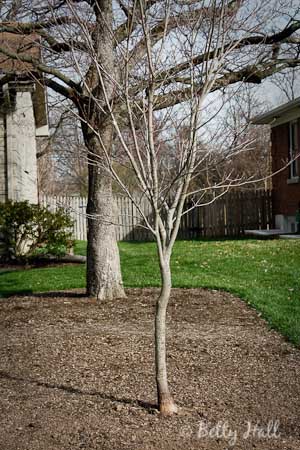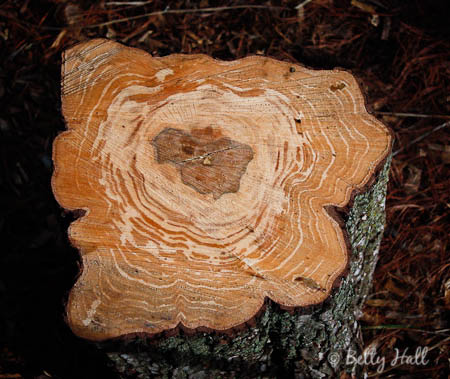I like flowering dogwood trees (Cornus florida). One of my favorite memories is of an Easter Sunday in the Red River Gorge when I coined the phrase “dogwood lace all over the place.”
Previous owners of our home planted two dogwoods in the front yard. We’ve enjoyed the beauty and subtle fragrance of their showy April blossoms, summer foliage and shade, colorful leaves and red berries in autumn, and the branches and checkered bark in winter.
Our trees are 50 years old. Last week we removed one that was dying and replaced it with a young one. Looking toward our backyard you can see the newly planted tree and the older one.
In the wild, dogwoods are seriously threatened by a fungus, dogwood anthracnose. However, according to the Bernheim Arboretum, “the fungus requires high humidity for infection, so trees growing on moist, shady sites are most susceptible… Hearty, well-maintained flowering dogwood trees in sunny areas with good air circulation and proper soil moisture are rarely impacted by anthracnose.” Our location gets plenty of sun so we feel comfortable replanting.
Most of our tree has been cut up for fireplace wood. However, we saved a portion of the trunk for a small outdoor stool. I expect tree experts could extract data from this stump. I’m content to enjoy the beautiful pattern.
In addition to their visual beauty, dogwoods are a host for spring azure butterflies and various moths including the large colorful Polyphemus moth. Birds feed on the caterpillars in summer and quickly devour the red berries in autumn.
I look forward to watching our young tree grow and seeing what visitors it attracts.




thanks for all the interesting info. we also have a dogwood we planted 3 years ago so still young and it also is in a sunny location – I’m just 2 seasons into the butterfly raise and release and wasn’t aware that the azure was fond of the dogwood. I totally enjoy your blogs and one day hope to set up my own site with help from my daughter in law who does it for a living ; )
Thanks, Christine. I hope you will set up a blog. There may be a way to do a group blog – maybe a group who appreciates butterflies? Wouldn’t that be fun?
good job. i love the image of the trunk. i gave a talk to a garden club today and mentioned how important the native dogwoods are…Doug Tallamy reports that 117 species of native insects use dogwood as a host plant. When the birds are eating the berries they can also search for protein! In contrast, the kousa dogwood provides food for ZERO insects (no protein for birds).
Thanks, Connie. I appreciate you adding this information.
I recently moved out in the country and trees are numerous . I am having some trouble determining which trees are dogwoods. We are clearing our land. Can anyone tell me a distinct way of determining what is what? Your site thinks my comment is a duplicate and I have never commented before
Hi Marie,
Spring is a good time to watch for flowering trees – e.g., dogwoods, redbud, and service berry. Watch to see what blooms, and consider flagging the trees you want to keep.
Beyond that, I encourage you to start learning basic tree identification. There are lots of good books, and this looks like a helpful website: https://www.treehugger.com/identify-name-tree-using-leaf-key-1343488.
You may also be able to contact your county extension agent for help. They may even be able to recommend a land management plan.
Betty
I was given a dogwood tree as a memorial when my son passed away three years ago. It had leaves on it for two years and then the deer ate them. This year not a single leaf. I’m assuming it’s dead. Is there any chance it’s not? I’d love to save it if possible.
Hi Patty,
Repeated browsing can kill a tree sprout, but there’s a chance the roots are still alive. Protect it so the deer can’t eat it and see if it comes out next year. If not, it’s probably time to buy a new one.
Best wishes, Betty